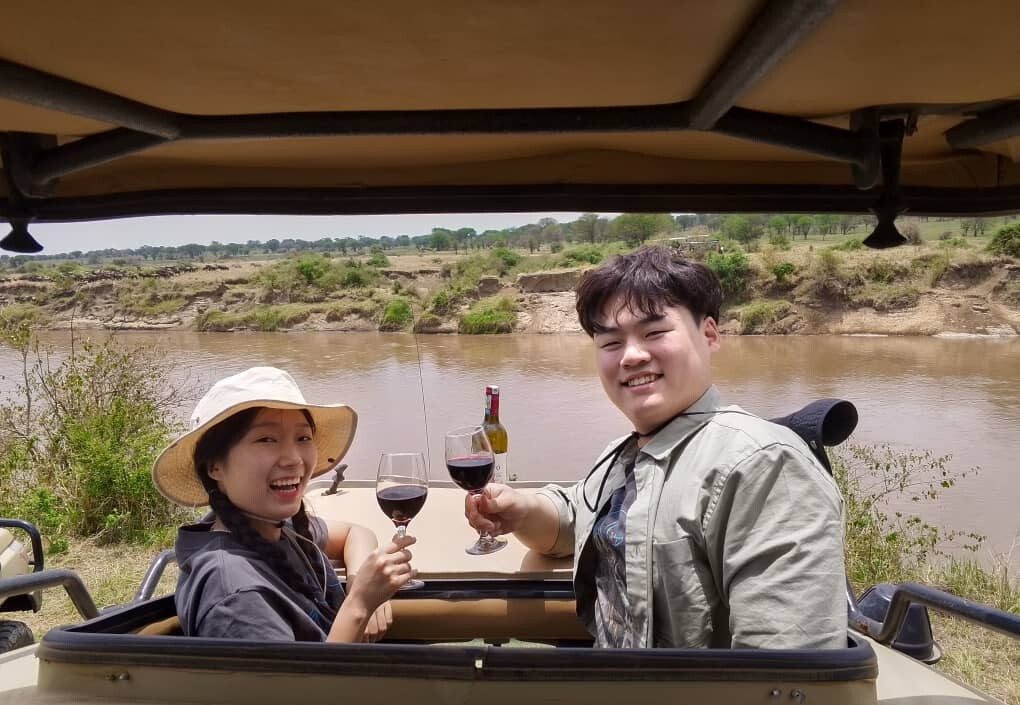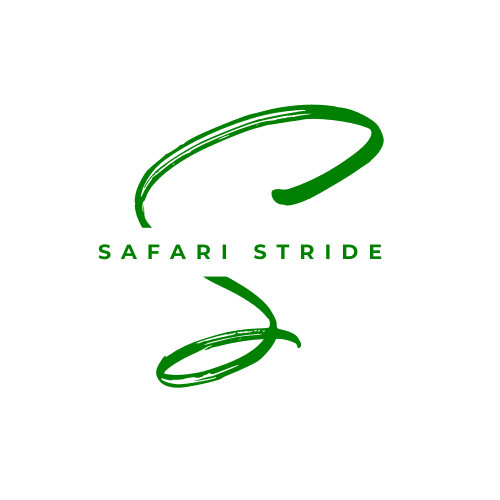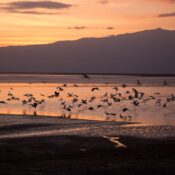Ruaha National Park: Discover Tanzania Greatest Wilderness
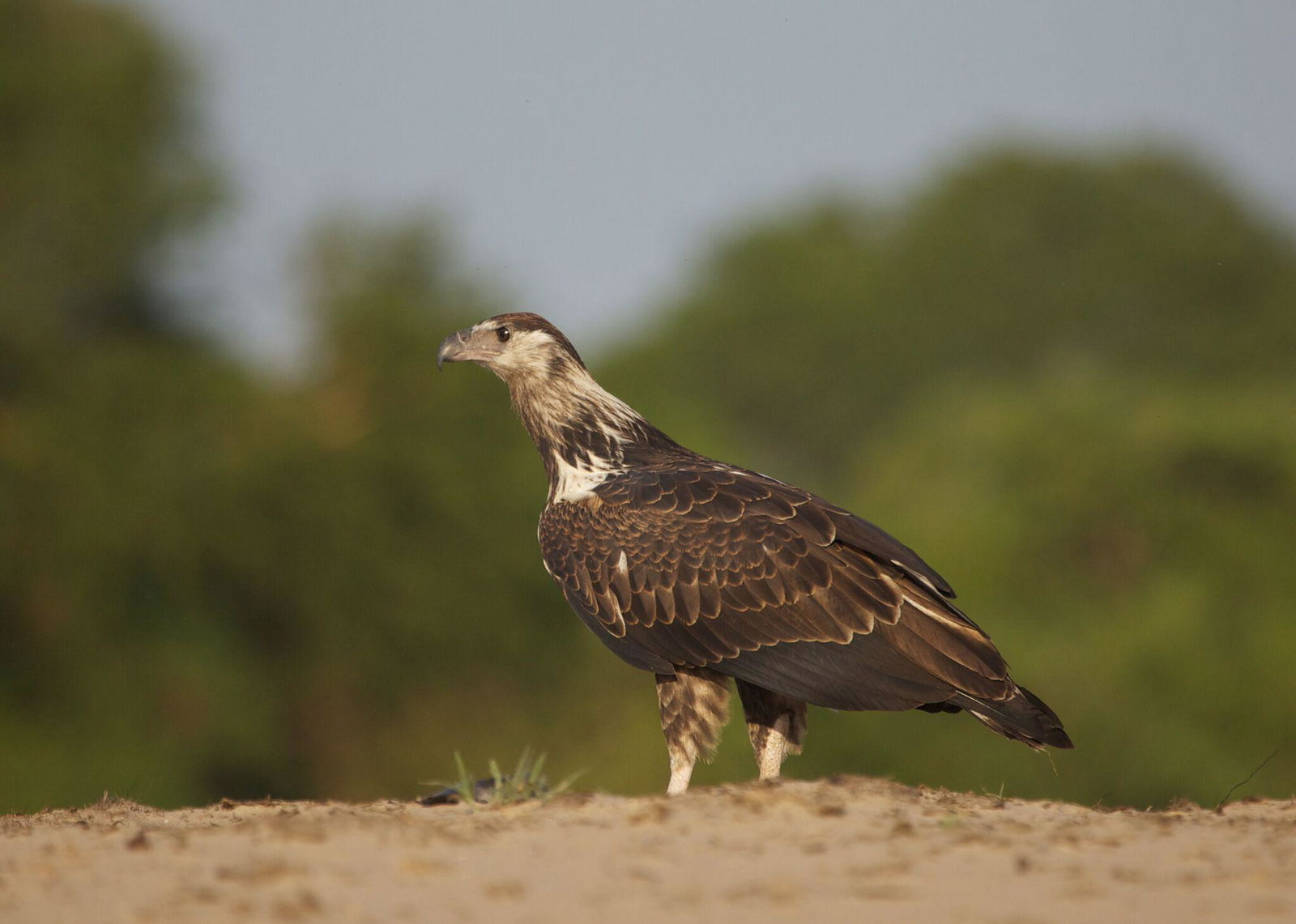
Ruaha National Park: Discover Tanzania Greatest Wilderness
Ruaha National Park stands as Tanzania’s largest national park and one of Africa’s most spectacular yet underexplored wilderness destinations, offering visitors an authentic safari experience far removed from the crowds of more famous northern circuit parks. Covering over 20,000 square kilometers of pristine African landscape, Ruaha National Park represents the heart of Tanzania’s southern safari circuit and provides some of the continent’s most exceptional wildlife viewing opportunities in a setting that feels truly wild and untouched.
Table of Contents
Located in south-central Tanzania, Ruaha National Park serves as a crucial wildlife sanctuary where East African and Southern African ecosystems converge, creating unique biodiversity that supports massive elephant populations, incredible predator densities, and over 570 bird species. The park’s remote location and challenging accessibility during certain seasons mean that visitors to Ruaha National Park often experience the privilege of having vast wilderness areas virtually to themselves, creating intimate wildlife encounters impossible in more crowded destinations.
The Great Ruaha River, from which the park takes its name, flows through the heart of this wilderness area, creating a lifeline that sustains incredible concentrations of wildlife during the dry season. Along its banks and seasonal tributaries, visitors to Ruaha National Park witness dramatic scenes of survival as animals compete for precious water resources, predators capitalize on concentrated prey populations, and the ancient rhythms of African wilderness play out in spectacular fashion.
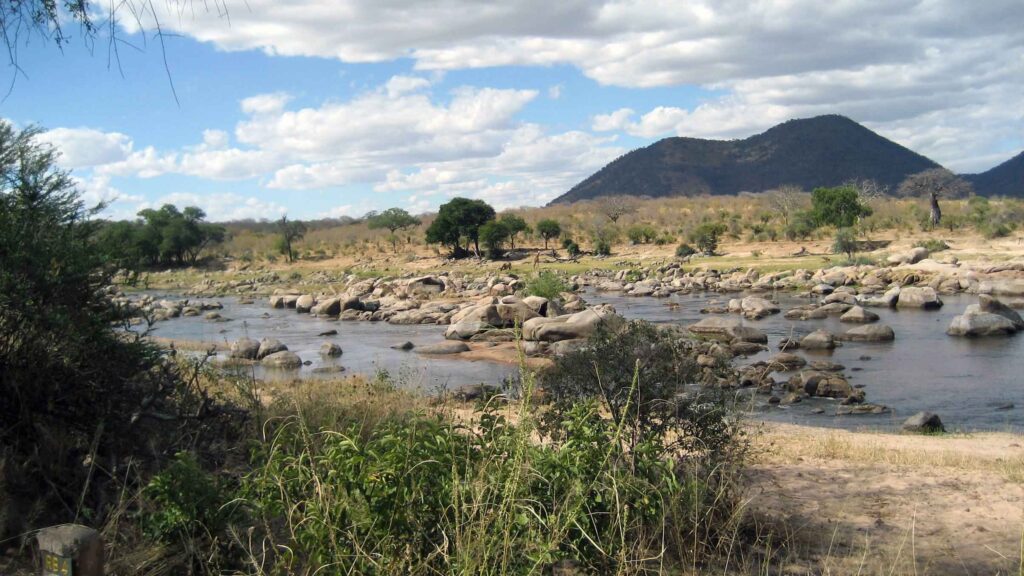
Geography and Landscape of Ruaha National Park
Ruaha National Park encompasses diverse ecosystems that range from rolling hills and granite kopjes to vast plains, seasonal wetlands, and riverine forests along the Great Ruaha River and its tributaries. This geographical diversity creates multiple habitat types within the park boundaries, supporting an incredible variety of wildlife species and providing visitors with constantly changing scenery throughout their safari experience.
The park’s elevation varies from approximately 750 meters to 1,900 meters above sea level, creating microclimates that influence vegetation patterns and wildlife distributions. The higher elevations in the western portions of Ruaha National Park support different plant communities than the lower eastern areas, contributing to the park’s remarkable biodiversity and creating distinct zones that attract different wildlife species throughout the year.
Rocky outcrops and granite formations scattered throughout Ruaha National Park provide dramatic focal points for photography while serving as crucial habitat for specialized wildlife species. These geological features create natural vantage points for predators, shelter for smaller mammals, and nesting sites for numerous bird species, making them hotspots for wildlife activity and essential stops during game drives.
The Great Ruaha River system represents the park’s most significant geographical feature, with its seasonal flow patterns determining wildlife movements and concentrations throughout the year. During the dry season, the river becomes a series of pools connected by sandy channels, creating natural amphitheaters where wildlife congregates and predator-prey interactions intensify dramatically.
Seasonal wetlands and floodplains within Ruaha National Park transform dramatically between wet and dry seasons, supporting different wildlife communities and vegetation patterns depending on water availability. These dynamic landscapes showcase the adaptability of African ecosystems while providing visitors with dramatically different experiences depending on their timing of visits to the park.
The convergence of different biogeographical zones within Ruaha National Park creates unique transitional habitats where species from different African regions overlap and interact. This convergence zone supports wildlife species typically found in East Africa alongside those more common in Southern Africa, creating exceptional biodiversity that sets Ruaha apart from other Tanzanian national parks.
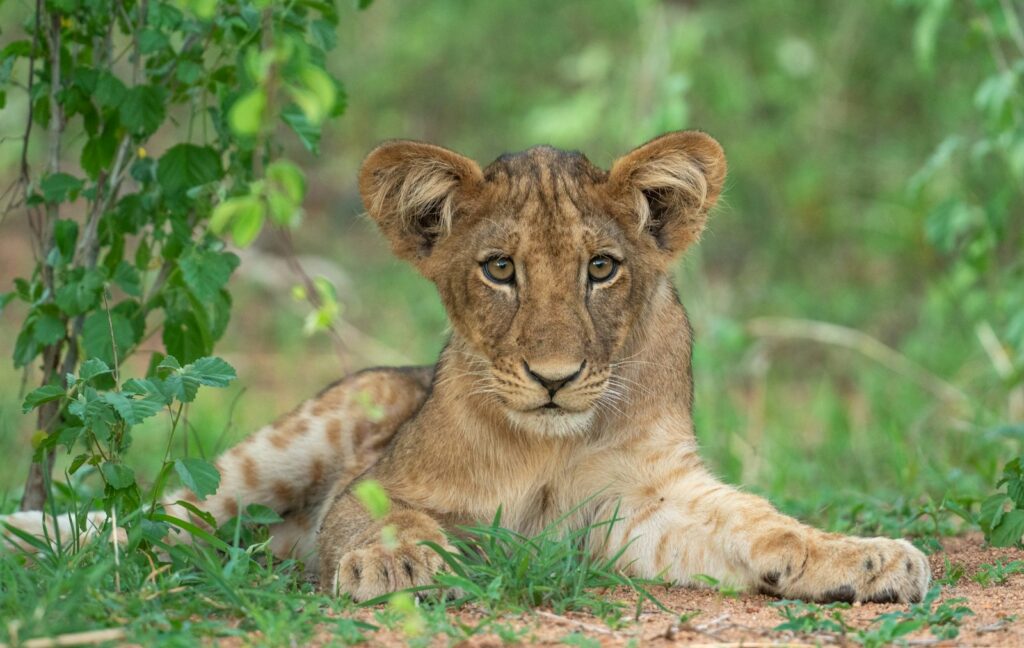
Wildlife Diversity in Ruaha National Park
Ruaha National Park supports one of Tanzania’s most diverse and abundant wildlife populations, with the park serving as a crucial sanctuary for numerous threatened and endangered species while maintaining healthy populations of Africa’s most iconic wildlife. The park’s remote location and vast size allow for natural wildlife behaviors and movements that have been disrupted in smaller or more developed conservation areas.
Elephant populations in Ruaha National Park represent one of Tanzania’s most significant conservation success stories, with an estimated 15,000 elephants calling the park home. These massive herds create some of Africa’s most spectacular elephant viewing opportunities, particularly during the dry season when family groups congregate along the Great Ruaha River. The sight of hundreds of elephants gathered at river pools represents one of the most moving wildlife experiences available anywhere in Africa.
Predator populations in Ruaha National Park reach exceptional densities, with the park supporting large prides of lions, significant leopard populations, and healthy numbers of both spotted and striped hyenas. The park’s lion populations have adapted to the challenging dry season conditions by developing sophisticated hunting strategies that take advantage of concentrated prey populations around permanent water sources.
Wild dog populations in Ruaha National Park represent some of Tanzania’s most viable packs of these endangered predators, with the park’s vast wilderness areas providing ideal habitat for wide-ranging hunting expeditions. Visitors to Ruaha National Park often witness dramatic wild dog hunts across the park’s open plains, experiencing firsthand the incredible coordination and athleticism that makes these predators so successful.
Buffalo herds in Ruaha National Park can number in the thousands, creating spectacular viewing opportunities particularly during river crossings and when large herds move between grazing areas. These massive congregations attract significant predator attention, resulting in dramatic wildlife interactions that showcase the intense competition for survival in African wilderness areas.
Antelope diversity in Ruaha National Park exceeds that found in most other Tanzanian parks, with species ranging from tiny dikdiks to massive eland, greater and lesser kudu, sable antelope, and roan antelope. This diversity reflects the park’s position at the convergence of different biogeographical zones and provides wildlife enthusiasts with opportunities to observe species rarely seen elsewhere in Tanzania.
Hippo populations thrive in the permanent pools of the Great Ruaha River, with these massive mammals creating focal points for wildlife activity as their presence attracts crocodiles, water birds, and other river-dependent species. The interaction between hippos and crocodiles in Ruaha’s river pools provides visitors with incredible wildlife viewing and photography opportunities.
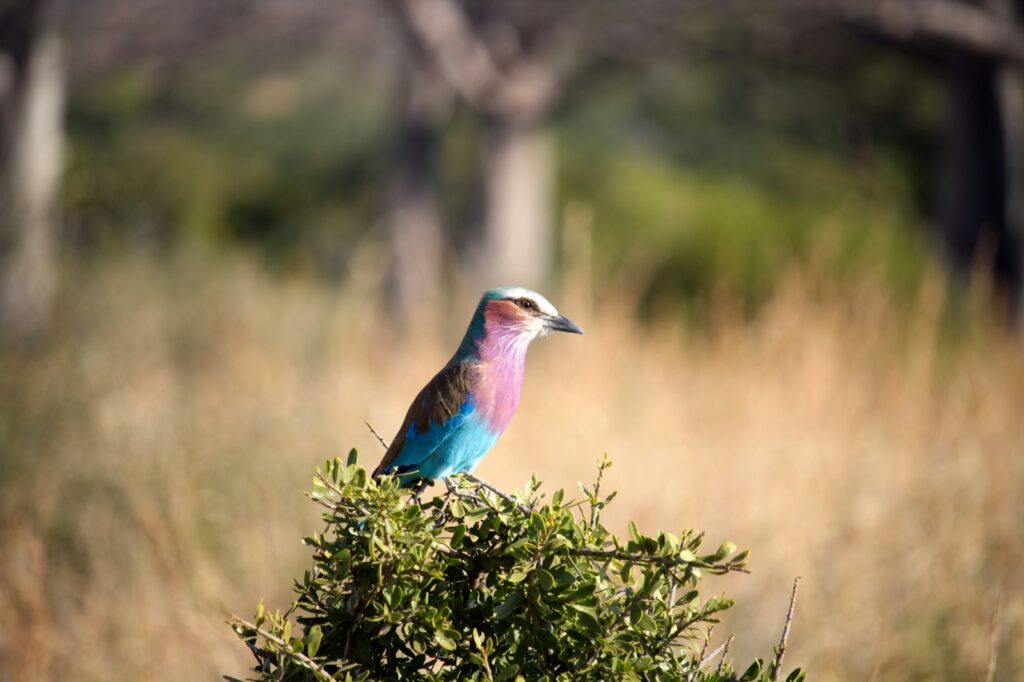
Birdwatching Paradise in Ruaha National Park
Ruaha National Park ranks among Tanzania’s premier birdwatching destinations, with over 570 recorded bird species representing both resident populations and seasonal migrants from across Africa and beyond. The park’s diverse habitats support an incredible variety of avian life, from tiny sunbirds to massive ground hornbills, creating opportunities for birdwatchers to observe species rarely encountered elsewhere.
Migratory patterns bring numerous European and Asian bird species to Ruaha National Park during the northern hemisphere winter, significantly increasing the park’s already impressive bird diversity. These seasonal visitors join resident populations to create spectacular birdwatching opportunities, particularly during the wet season when insect populations support increased feeding activity and breeding behaviors.
Endemic and near-endemic species found in Ruaha National Park include several birds whose ranges are restricted to this region of Tanzania, making the park essential for serious birdwatchers seeking to observe rare and localized species. The Ruaha red-billed hornbill and other regionally restricted species represent highlights for visiting ornithologists and bird photographers.
Raptors thrive in Ruaha National Park’s open landscapes, with the park supporting impressive populations of eagles, hawks, falcons, and vultures. The abundance of prey species and carrion from predator kills creates ideal conditions for raptors, resulting in spectacular aerial displays and hunting behaviors that captivate wildlife observers.
Water birds congregate around the Great Ruaha River and seasonal wetlands, with species including various herons, egrets, storks, and kingfishers taking advantage of aquatic feeding opportunities. The seasonal variation in water levels creates different habitat conditions that attract different species throughout the year, ensuring rewarding birdwatching regardless of visit timing.
Ground-dwelling birds in Ruaha National Park include the impressive southern ground hornbill, various francolin species, and other terrestrial birds that have adapted to the park’s diverse habitat conditions. These species often provide unexpected encounters during game drives and walking safaris, adding variety to wildlife viewing experiences.
The park’s position at the convergence of different biogeographical zones creates opportunities to observe bird species typical of both East and Southern African avifaunas within the same location. This unique characteristic makes Ruaha National Park particularly valuable for birdwatchers seeking to maximize their African bird species observations during limited travel time.
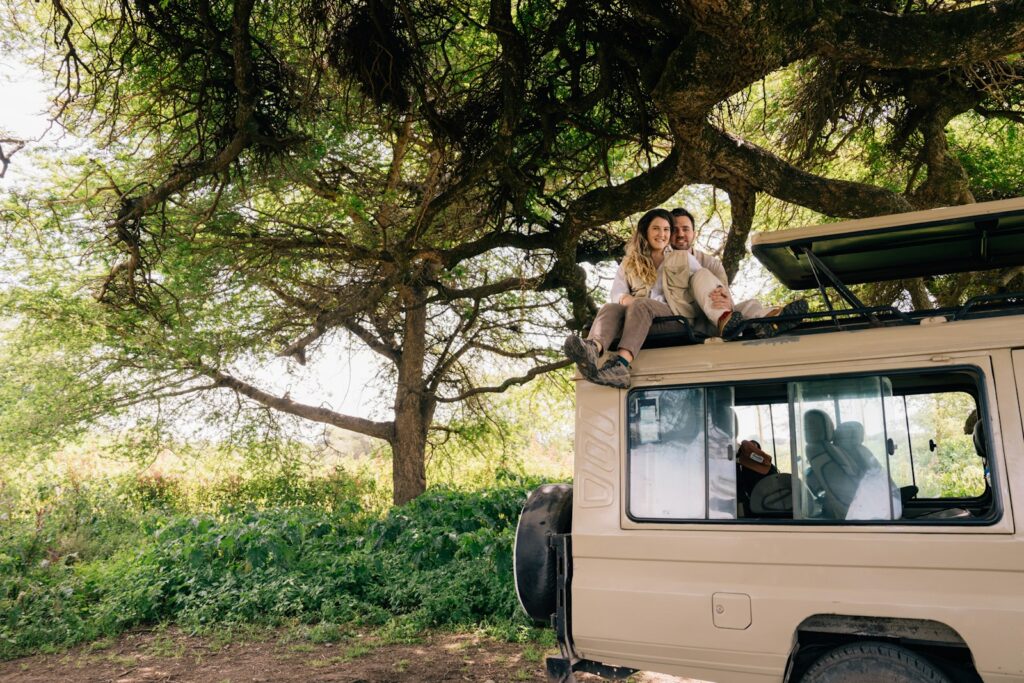
Best Time to Visit Ruaha National Park
Determining the optimal time to visit Ruaha National Park requires understanding the park’s dramatic seasonal variations and how these changes affect wildlife viewing opportunities, accessibility, and overall safari experiences. The park’s location in Tanzania’s interior creates distinct wet and dry seasons that dramatically transform landscapes, wildlife behaviors, and travel conditions.
The dry season from June to October represents the traditional peak time to visit Ruaha National Park, offering exceptional wildlife viewing conditions as animals concentrate around permanent water sources along the Great Ruaha River. During these months, sparse vegetation makes wildlife spotting significantly easier, while predictable animal movements around water sources create outstanding opportunities for photography and wildlife observation.
Early dry season visits to Ruaha National Park from June to July provide excellent wildlife viewing while avoiding the intense heat and dust of later dry season months. During this period, the landscape retains some green vegetation from recent rains while wildlife concentrations begin building around permanent water sources, creating ideal conditions for first-time visitors to the park.
Peak dry season months from August to October offer the most dramatic wildlife concentrations in Ruaha National Park, with massive elephant herds, large predator populations, and concentrated game creating incredible viewing opportunities. However, these months also bring the highest temperatures, most dust, and strongest competition for limited water resources, resulting in intense wildlife interactions.
Late dry season visits to Ruaha National Park from September to October provide the most spectacular wildlife viewing opportunities as animal concentrations reach their maximum intensity around shrinking water sources. The dramatic scenes of survival during this period create unforgettable wildlife experiences, though the harsh conditions require appropriate preparation and expectations.
Wet season visits to Ruaha National Park from November to May offer completely different experiences, with lush landscapes, excellent birdwatching opportunities, and unique wildlife behaviors that cannot be observed during dry season visits. However, many areas of the park become inaccessible during heavy rains, and some accommodation facilities close for portions of the wet season.
The short rains from November to December can provide excellent value for visitors to Ruaha National Park willing to accept some weather uncertainty, with reduced accommodation rates and fewer crowds while wildlife remains relatively concentrated from dry season patterns. This period often offers the best compromise between weather conditions, wildlife viewing, and cost considerations.
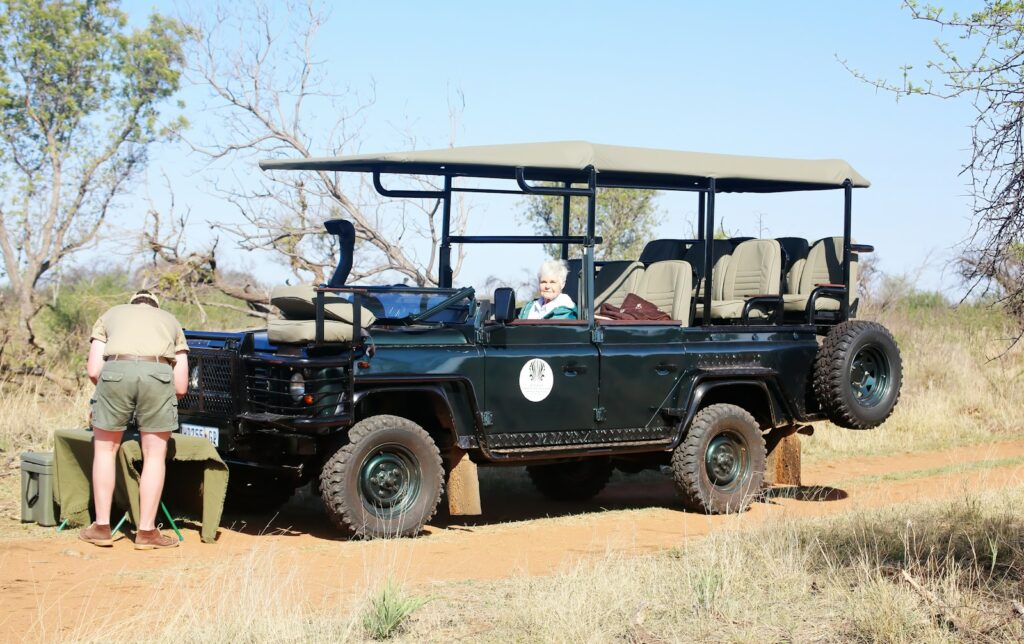
Safari Activities in Ruaha National Park
Ruaha National Park offers diverse safari activities that take advantage of the park’s vast wilderness areas, diverse landscapes, and exceptional wildlife populations while providing visitors with multiple ways to experience this remarkable ecosystem. The park’s remote location and limited development create opportunities for authentic wilderness experiences rarely available in more developed safari destinations.
Game drives represent the primary safari activity in Ruaha National Park, with the park’s extensive road network providing access to diverse habitats and wildlife viewing opportunities throughout the year. The park’s size means that game drives can vary dramatically in character, from intensive wildlife viewing along the Great Ruaha River to exploratory drives through remote wilderness areas where human presence is minimal.
Full-day game drives in Ruaha National Park allow visitors to explore the park’s vast wilderness areas thoroughly while maximizing wildlife viewing opportunities across different habitat zones. These extended excursions often include picnic lunches in spectacular wilderness settings, creating opportunities to experience the park’s incredible silence and sense of isolation that defines authentic African wilderness.
Walking safaris in Ruaha National Park provide intimate wilderness experiences that allow visitors to engage with the African bush on foot while learning about ecosystems, animal behavior, and survival skills from expert guides. The park’s size and wildlife populations create excellent opportunities for walking safaris, though these activities require careful planning and experienced guides due to the presence of dangerous game.
Night game drives in certain areas of Ruaha National Park offer opportunities to observe nocturnal wildlife behaviors and species rarely seen during daylight hours, including leopards, hyenas, and various smaller predators that become active after dark. These specialized activities provide unique insights into the park’s ecosystem while creating memorable experiences unavailable during standard daytime game viewing.
Photography safaris in Ruaha National Park cater to serious wildlife photographers seeking to capture images of the park’s spectacular wildlife in pristine wilderness settings. The park’s incredible elephant herds, dramatic predator interactions, and beautiful landscapes create exceptional photographic opportunities, while the relatively low visitor numbers ensure uncrowded conditions ideal for photography.
Cultural visits to communities surrounding Ruaha National Park provide insights into traditional lifestyles and conservation relationships between local peoples and wildlife areas. These experiences complement wildlife viewing while supporting community conservation initiatives that benefit both local residents and wildlife protection efforts.
Fly camping experiences in Ruaha National Park allow adventurous visitors to spend nights in temporary camps set up in remote wilderness areas, providing ultimate immersion in African wilderness while maintaining safety standards appropriate for the park’s challenging environment. These specialized experiences require advance booking and careful planning but offer unparalleled wilderness authenticity.
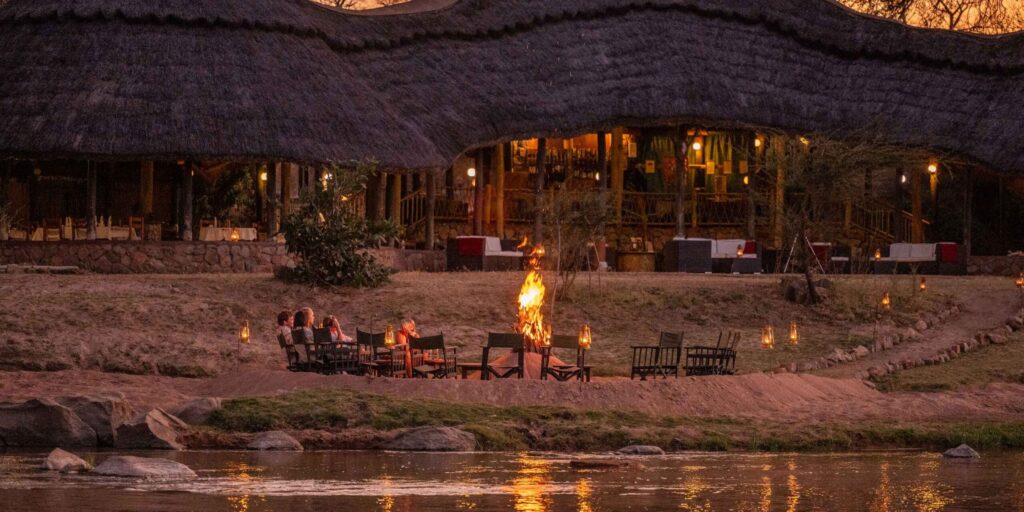
Accommodation Options in Ruaha National Park
Accommodation options within and around Ruaha National Park range from luxury safari lodges to more rustic bush camps, though the park’s remote location means fewer choices than found in Tanzania’s northern circuit parks. The available accommodations generally emphasize authentic wilderness experiences over luxury amenities while maintaining safety and comfort standards appropriate for the challenging environment.
Luxury safari lodges in Ruaha National Park provide exceptional comfort and service while maintaining authentic African ambiance that complements the wilderness setting. These properties typically offer spacious accommodations with private verandas overlooking the Great Ruaha River or other scenic areas, creating intimate connections with the surrounding wildlife and landscapes.
Safari camps in Ruaha National Park provide more rustic but authentic accommodation experiences that emphasize connection with the wilderness environment while offering comfortable amenities essential for safari comfort. These camps often provide more flexible scheduling and personalized service than larger lodges while maintaining the safety standards necessary for remote wilderness locations.
Mobile camping options allow visitors to experience different areas of Ruaha National Park during extended stays, with temporary camps set up in various locations to maximize wildlife viewing opportunities and wilderness experiences. These specialized accommodations require advance planning but offer ultimate flexibility and authenticity for adventurous travelers.
Seasonal accommodation considerations affect availability and pricing throughout the year, with some facilities closing during the wettest months when access becomes challenging or impossible. Understanding these seasonal patterns helps in planning visits to Ruaha National Park while ensuring accommodation availability during desired travel periods.
Location considerations for accommodation in Ruaha National Park significantly impact wildlife viewing opportunities and overall experiences, with properties along the Great Ruaha River offering different advantages than those in more remote wilderness areas. The choice of accommodation location should align with individual preferences for wildlife viewing priorities and wilderness immersion levels.
Booking considerations for Ruaha National Park accommodations require advance planning due to limited capacity and the park’s remote location, with peak season reservations often required months in advance. However, the limited accommodation options help ensure that wildlife viewing experiences remain uncrowded and authentic throughout the year.
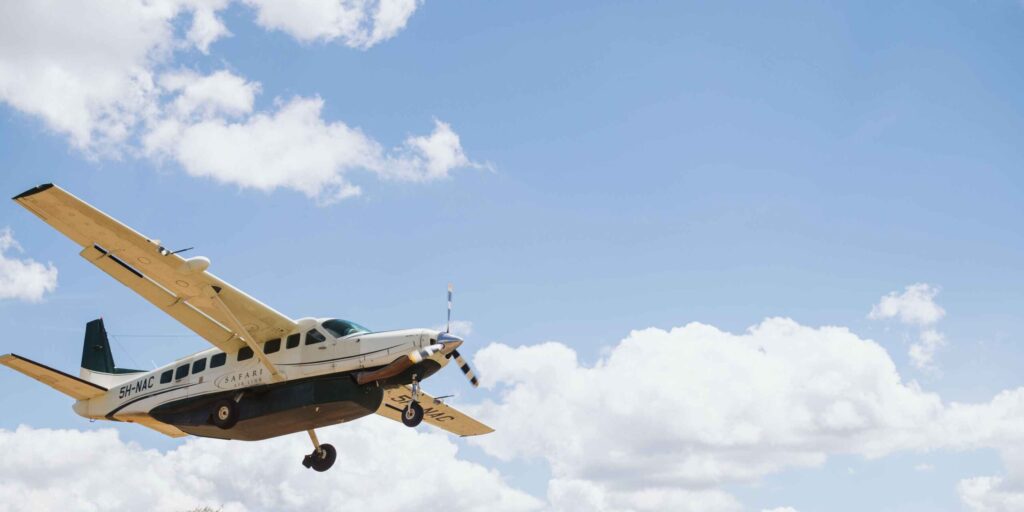
Getting to Ruaha National Park
Reaching Ruaha National Park requires careful planning due to its remote location and limited transportation options, with access methods varying significantly in cost, convenience, and travel time. Understanding the available transportation options helps visitors choose approaches that match their budget, schedule, and comfort preferences while ensuring safe arrival at this remote wilderness destination.
Flying to Ruaha National Park represents the most convenient and time-efficient access method, with scheduled and charter flights connecting the park to Dar es Salaam, Arusha, and other Tanzanian destinations. The park’s airstrip accommodates small aircraft while providing spectacular aerial views of the wilderness areas during approach and departure.
Road access to Ruaha National Park involves long drives over challenging roads that can become impassable during wet season conditions, making this access method suitable primarily for adventurous travelers with appropriate vehicles and plenty of time. The overland journey provides opportunities to observe rural Tanzanian landscapes and communities while emphasizing the park’s remote wilderness character.
Driving distances to Ruaha National Park from major Tanzanian cities are substantial, with the journey from Dar es Salaam taking approximately 10-12 hours under good conditions, while access from Arusha requires similar travel time. These driving times assume good road conditions and no delays, both of which can be challenging assumptions during certain seasons.
Seasonal access considerations significantly affect transportation options and reliability, with wet season conditions potentially making road access impossible while flight schedules may be reduced due to weather challenges. Planning visits during dry season months generally ensures more reliable transportation options and fewer travel complications.
Combined transportation approaches may offer optimal solutions for some visitors, such as flying one direction and driving the other to experience different perspectives on Tanzania’s landscapes while managing time and budget considerations effectively. These combined approaches require careful coordination but can enhance overall travel experiences.
Charter flight options provide maximum flexibility and convenience for reaching Ruaha National Park, particularly for visitors with limited time or those seeking to combine the park with other remote Tanzanian destinations. Charter services can accommodate varying group sizes while providing customized scheduling that matches specific itinerary requirements.

Conservation and Research in Ruaha National Park
Ruaha National Park serves as a crucial conservation area for protecting Tanzania’s wildlife populations and ecosystems while supporting important scientific research that contributes to broader conservation knowledge and strategies. The park’s size and ecological diversity make it an ideal location for long-term studies of African wildlife populations and ecosystem dynamics.
Elephant conservation efforts in Ruaha National Park have achieved significant success in protecting one of Tanzania’s largest elephant populations while demonstrating effective strategies for human-wildlife conflict resolution and community engagement. The park’s elephant populations serve as important seed populations for broader conservation efforts throughout the region while supporting research into elephant behavior, ecology, and conservation strategies.
Anti-poaching initiatives in Ruaha National Park involve partnerships between park authorities, conservation organizations, and local communities to protect wildlife from illegal hunting while providing alternative livelihoods for community members. These comprehensive programs address both immediate threats and underlying causes of poaching while building long-term support for conservation among local stakeholders.
Research programs operating in Ruaha National Park focus on various aspects of ecosystem function, wildlife behavior, and conservation effectiveness while training local researchers and contributing to international scientific knowledge. The Ruaha Carnivore Project represents one of Africa’s most comprehensive predator research initiatives, providing crucial insights into carnivore ecology and conservation strategies.
Community conservation programs surrounding Ruaha National Park work to integrate local communities into conservation efforts while providing tangible benefits that support both conservation goals and community development objectives. These programs demonstrate successful models for conservation approaches that benefit both wildlife and human communities while ensuring long-term sustainability.
Climate change research in Ruaha National Park examines how changing weather patterns affect ecosystem function, wildlife populations, and conservation strategies while developing adaptation approaches for managing protected areas under changing environmental conditions. This research contributes to broader understanding of climate change impacts on African ecosystems while informing management decisions.
International partnerships support conservation and research efforts in Ruaha National Park through funding, technical expertise, and capacity building programs that enhance local conservation capabilities while contributing to global conservation knowledge. These partnerships demonstrate successful models for international conservation collaboration while ensuring local ownership and sustainability.

Photography Opportunities in Ruaha National Park
Ruaha National Park provides exceptional photography opportunities that combine spectacular wildlife subjects with pristine wilderness settings and dramatic lighting conditions that serious wildlife photographers seek. The park’s remote location and limited visitor numbers create ideal conditions for photography while ensuring minimal human interference with natural wildlife behaviors.
Elephant photography in Ruaha National Park offers some of Africa’s most spectacular opportunities to capture images of large herds in natural wilderness settings, with the Great Ruaha River providing dramatic backdrops and excellent lighting conditions throughout the day. The predictable elephant movements during dry season create opportunities for planning specific shots while the animals’ tolerance of vehicles allows for relatively close approaches.
Predator photography in Ruaha National Park benefits from the park’s exceptional predator densities and natural hunting behaviors, with opportunities to photograph lions, leopards, wild dogs, and hyenas in authentic wilderness contexts. The park’s open landscapes and strategic positioning opportunities create ideal conditions for capturing predator interactions and hunting sequences.
Landscape photography in Ruaha National Park showcases the dramatic beauty of pristine African wilderness, with opportunities ranging from sunrise and sunset shots over the Great Ruaha River to dramatic storm photography during wet season visits. The park’s diverse landscapes provide constantly changing photographic opportunities while the limited development ensures unobstructed wilderness views.
Bird photography opportunities in Ruaha National Park cater to photographers seeking to capture images of both common and rare African bird species in natural settings, with the park’s incredible diversity providing subjects ranging from tiny sunbirds to massive ground hornbills. The varied habitats within the park create different lighting and compositional opportunities for bird photography throughout the day.
Macro photography in Ruaha National Park allows photographers to explore the smaller wildlife and natural details that contribute to ecosystem function while providing different perspectives on African wilderness. The park’s diverse plant communities and insect populations create numerous opportunities for close-up photography that complements traditional wildlife imaging.
Technical considerations for photography in Ruaha National Park include managing dust and heat during dry season visits while preparing for potential weather challenges during wet season photography. The park’s remote location means limited opportunities for equipment repairs or replacements, making careful preparation and backup equipment essential for serious photography expeditions.
Professional photography services and guides available in Ruaha National Park can enhance photography experiences through local knowledge, optimal positioning, and specialized equipment access while ensuring safety standards appropriate for the park’s challenging environment. These services can significantly improve photography outcomes while providing educational opportunities for developing technical and compositional skills.
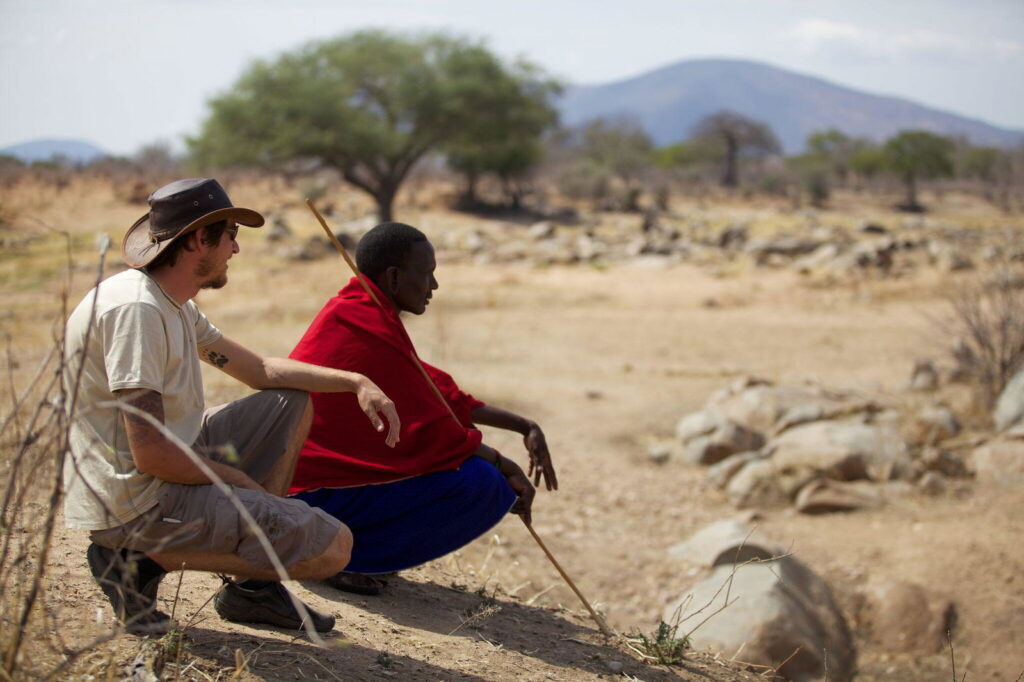
Cultural Experiences Around Ruaha National Park
Cultural experiences surrounding Ruaha National Park provide insights into traditional Tanzanian lifestyles while demonstrating the complex relationships between local communities and wildlife conservation efforts. These experiences complement wildlife viewing while supporting community development initiatives that benefit both conservation and local residents.
Traditional communities surrounding Ruaha National Park include various ethnic groups with distinct cultural practices, languages, and relationships with the natural environment that have evolved over centuries of coexistence with wildlife. Understanding these cultural contexts enhances appreciation for conservation challenges while providing meaningful cultural exchange opportunities.
Community visits organized through responsible tourism operators provide opportunities to observe traditional crafts, agricultural practices, and social structures while supporting local economies through tourism revenue. These experiences require sensitive approaches that respect community privacy and autonomy while providing mutual benefits for visitors and residents.
Traditional hunting and gathering practices among communities surrounding Ruaha National Park reflect sophisticated understanding of ecosystem function and sustainable resource use that predates modern conservation approaches. Learning about these traditional practices provides insights into indigenous conservation knowledge while highlighting the complexity of contemporary conservation challenges.
Cultural festivals and celebrations in communities around Ruaha National Park provide opportunities to observe traditional music, dance, and social practices while participating in authentic cultural expressions. These events typically occur during specific seasons and require advance planning to coordinate with travel schedules.
Community conservation initiatives demonstrate successful approaches to integrating local communities into wildlife protection efforts while providing tangible benefits that support both conservation goals and community development. These programs showcase innovative approaches to conservation that address both wildlife protection and human needs.
Traditional medicine practices in communities surrounding Ruaha National Park reflect sophisticated understanding of plant properties and ecosystem relationships while highlighting the importance of biodiversity conservation for supporting traditional knowledge systems. Learning about traditional medicine provides insights into indigenous knowledge while emphasizing conservation importance.
Educational exchanges between visitors and community members create opportunities for mutual learning about different approaches to environmental management, conservation, and sustainable living while building cross-cultural understanding and support for conservation efforts.
Planning Your Ruaha National Park Safari
Planning a successful safari to Ruaha National Park requires understanding the park’s unique characteristics, seasonal variations, and logistical requirements while balancing wildlife viewing priorities with practical considerations such as budget, time constraints, and comfort preferences. Advance planning becomes particularly important due to the park’s remote location and limited accommodation options.
Itinerary planning for Ruaha National Park should consider the park’s size and the time required to experience its diverse wildlife and landscapes adequately, with most visitors benefiting from minimum stays of 3-4 days to justify the travel time and costs involved in reaching this remote destination. Longer stays allow for more comprehensive exploration while increasing chances of witnessing special wildlife behaviors and interactions.
Seasonal considerations significantly impact safari planning for Ruaha National Park, with dry season visits requiring different preparation and expectations than wet season trips. Understanding these seasonal differences helps in choosing optimal timing while preparing appropriately for expected conditions and wildlife viewing opportunities.
Budget planning for Ruaha National Park safaris should account for higher costs associated with the park’s remote location, including transportation expenses and limited accommodation options that may command premium pricing due to exclusivity and operational challenges. However, the park’s authentic wilderness experience and exceptional wildlife viewing often justify the additional investment.
Combination safari options allow visitors to experience Ruaha National Park alongside other Tanzanian destinations, creating comprehensive African experiences while managing transportation costs and time constraints effectively. Popular combinations include northern circuit parks, coastal destinations, or other southern circuit wilderness areas.
Equipment and packing considerations for Ruaha National Park reflect the park’s remote location and challenging environmental conditions, with visitors needing to prepare for dust, heat, and potential equipment limitations while ensuring appropriate clothing for various weather conditions and activities.
Health and safety preparations for Ruaha National Park visits require attention to medical requirements, insurance coverage, and emergency procedures appropriate for remote wilderness travel where medical facilities and evacuation options may be limited compared to more developed destinations.
Photography equipment planning for Ruaha National Park should consider the exceptional opportunities available while preparing for challenging environmental conditions that may affect equipment performance and longevity. The park’s remote location emphasizes the importance of backup equipment and protective measures for valuable photography gear.
Conclusion: Discovering Tanzania’s Wild Heart
Ruaha National Park represents the epitome of authentic African wilderness, offering visitors opportunities to experience pristine ecosystems, exceptional wildlife populations, and genuine solitude that has become increasingly rare in our developed world. The park’s vast landscapes, incredible biodiversity, and remote location create safari experiences that connect visitors with the raw beauty and power of untamed Africa while supporting crucial conservation efforts that protect these irreplaceable wilderness areas.
The decision to visit Ruaha National Park requires commitment to adventure, flexibility in expectations, and appreciation for authentic wilderness experiences over convenient tourist amenities. However, those willing to make this commitment discover one of Africa’s most rewarding safari destinations, where wildlife viewing reaches levels of intensity and authenticity that exceed expectations while providing memories that last a lifetime.
Conservation success stories in Ruaha National Park demonstrate the positive impact of dedicated protection efforts, community engagement, and sustainable tourism development that benefits both wildlife populations and local human communities. Visitors to the park contribute directly to these conservation efforts while experiencing firsthand the incredible wildlife populations that result from effective protection and management strategies.
The future of Ruaha National Park depends on continued support from international visitors, conservation organizations, and Tanzanian authorities who recognize the park’s crucial role in protecting Africa’s wildlife heritage for future generations. According to the Tanzania National Parks Authority (TANAPA), the park continues to receive increasing recognition for its conservation importance and exceptional visitor experiences.
As Tanzania’s largest national park and one of Africa’s most important wilderness areas, Ruaha National Park offers experiences that fulfill the dreams of serious safari enthusiasts while exceeding the expectations of first-time African visitors. The park’s combination of accessibility and remoteness, wildlife abundance and pristine landscapes, cultural authenticity and conservation success creates a destination that represents the very best of what African safari experiences can offer.
Planning a visit to Ruaha National Park represents an investment in authentic African adventure, meaningful conservation support, and personal experiences that provide lasting inspiration and connection with our planet’s incredible natural heritage. The park awaits those ready to discover Tanzania’s wild heart and experience Africa as it was meant to be experienced – wild, free, and absolutely unforgettable.
Recent Posts
